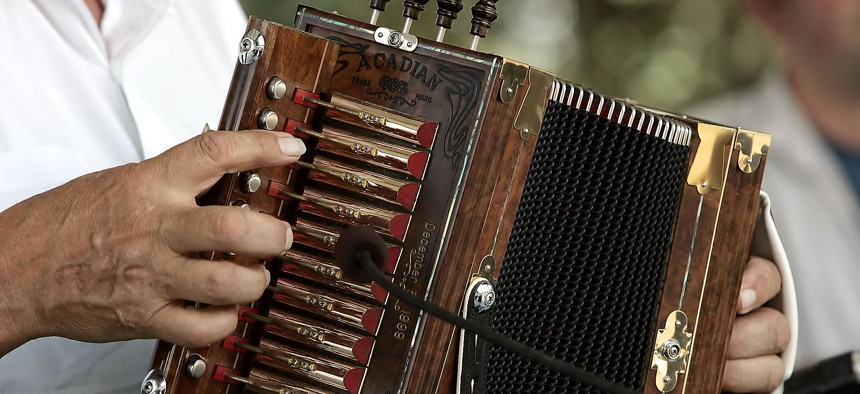A City-Run Database to Boost Local Arts and Culture

The experienced fingers of Marc Savoy, find their keys on the melodeon or cajun accordian at the at the Festivals Acadiens in Lafayette, La. AP Photo/Rogelio Solis

Connecting state and local government leaders
Lafayette, Louisiana is creating a cultural asset database as a way to make it easier to find and connect with local artists, musicians, venues, and others in creative industries.
Art and music hold special importance in Lafayette, Louisiana.
The Festival International, a free concert event that began in 1987, is credited with lifting the city out of an economic slump.
Tourism is the second-largest contributor to Lafayette’s economy, and the festival draws upwards of 300,000 people each year and generates $49 million in local spending. But beyond festivals, local officials wanted to do more to showcase the city’s artistic and musical talent. That’s how the idea of creating a cultural asset database was born.
Lafayette’s Chief Cultural Officer Kate Durio wants to create a searchable and mappable online database that can serve as a one-stop shop for all the city’s artists and cultural resources.
“There’s a really cool pride in the culture of Lafayette, being a French speaker, being of Cajun descent,” Durio said. “But we hadn’t had a concerted effort on how we can cultivate the new.”
The asset database would be a way to not only showcase and support the city’s creative class, but also to provide artists new ways to connect with others, and the city a way to understand the needs of its artistic community, Durio said.
The digital portal would allow local theater troupes, art studios, bands, chefs, instrument repair shops and others to create profile pages on the website showcasing their skills. The database would also be mappable, granting the city a better understanding of where its creative class is flourishing.
Older neighborhoods where much of the city’s arts and culture comes from have not received the same type of reinvestments that recently redeveloped neighborhoods have, Durio said. By mapping and understanding where those cultural assets are located, the city can target grant funding and reinvestment that might be most beneficial to the city’s creative class.
“The culture is just accepted as this great thing we have but it’s intangible in a way,” Durio said. “We’ve never had a way to see where our creative clustering is happening.”
The cultural asset database remains a work in progress, but Durio said it will go live before the end of the year. Fellows assisting with the project have already entered more than 800 “assets” into the database. These assets are broken down into six categories: artists; creative cultural industries; cultural heritage; festivals and events; natural heritage; and spaces and facilities.
“This seemed like the simplest concept and like a no brainer but it was crazy we had not thought of it before,” said Michelle Colón, one of 13 artists selected as a fellow to work on the project.
As part of the fellowships, the artists helped compile the asset database and also organized a series of roundtable discussions with local artists in their respective fields.
The public discussions brought in new voices who provided insight on the type of support the city could provide that would most benefit the arts, Colón said.
One example highlighted through public discussions with theater companies was the need for space to accommodate rehearsals and prop storage, Colón said.
“That’s an infrastructure thing and that’s something we could talk to the city about,” she said.
Other features of the asset portal will include the ability for bands and other artists to store contracts, riders, or other business forms. Artists will also be able to message one another through a Slack-like app on the portal.
The asset portal is being funded in part through the CREATE Initiative, which voters approved through a ballot initiative in 2017. The CREATE (Culture, Recreation, Entertainment, Arts, Tourism, Economy) Initiative receives $500,000 annually to support infrastructure and investment in the city’s creative and cultural industries.
To design, build and host the asset portal, Durio said the project will cost around $94,000 its first year with additional costs required for software licensing and hosting the website in the future. The city received a $20,000 grant from the National Endowment for the Arts to help fund the project.
Andrea Noble is a staff correspondent with Route Fifty.

NEXT STORY: Some States Move to Curtail Suspension and Expulsion of Students




